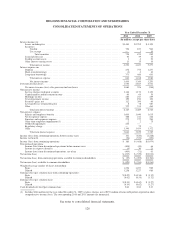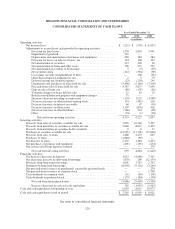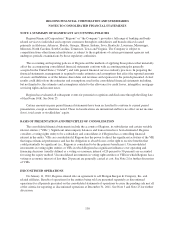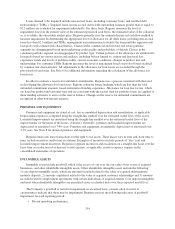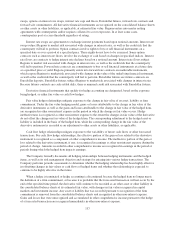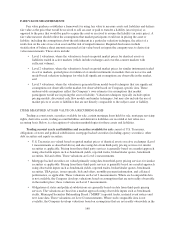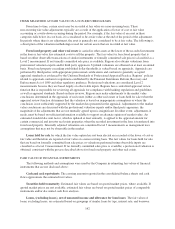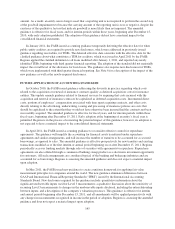Regions Bank 2011 Annual Report Download - page 159
Download and view the complete annual report
Please find page 159 of the 2011 Regions Bank annual report below. You can navigate through the pages in the report by either clicking on the pages listed below, or by using the keyword search tool below to find specific information within the annual report.• Changes in market capitalization,
• Regulatory actions and assessments,
• Changes in the business climate (including legislation, legal factors and competition),
• Company-specific factors (including changes in key personnel, asset impairments, and business
dispositions), and
• Trends in the banking industry.
Adverse changes in the economic environment, declining operations, or other factors could result in a
decline in the implied fair value of goodwill. A goodwill impairment test includes two steps. Step One, used to
identify potential impairment, compares the estimated fair value of a reporting unit with its carrying amount,
including goodwill. If the estimated fair value of a reporting unit exceeds its carrying amount, goodwill of the
reporting unit is considered not impaired. If the carrying amount of a reporting unit exceeds its estimated fair
value, the second step of the goodwill impairment test is performed to measure the amount of impairment loss, if
any. Step Two of the goodwill impairment test compares the implied estimated fair value of reporting unit
goodwill with the carrying amount of that goodwill. If the carrying amount of goodwill for that reporting unit
exceeds the implied fair value of that unit’s goodwill, an impairment loss is recognized in other non-interest
expense in an amount equal to that excess.
For purposes of performing Step One of the goodwill impairment test, Regions uses both the income and
market approaches to value its reporting units. Regions uses the output from these approaches to determine
estimated fair value of the reporting unit. The income approach, which is the primary valuation approach,
consists of discounting projected long-term future cash flows, which are derived from internal forecasts and
economic expectations for the respective reporting units. The projected future cash flows are discounted using
cost of capital metrics for Regions’ peer group or a build-up approach (such as the capital asset pricing model)
applicable to each reporting unit. The significant inputs to the income approach include expected future cash
flows, which are primarily driven by the long-term target tangible equity to tangible assets ratio, and the discount
rate, which is determined in the build-up approach using the risk-free rate of return, adjusted equity beta, equity
risk premium, and a company-specific risk factor. The company-specific risk factor is used to address the
uncertainty of growth estimates and earnings projections of management.
Regions uses the public company method and the transaction method as the two market approaches. The
public company method applies a value multiplier derived from each reporting unit’s peer group to a financial
metric of the reporting unit (e.g. last twelve months of earnings before interest, taxes and depreciation, tangible
book value, etc.) and an implied control premium to the respective reporting unit. The control premium is
evaluated and compared to similar financial services transactions. The transaction method applies a value
multiplier to a financial metric of the reporting unit based on comparable observed purchase transactions in the
financial services industry for the reporting unit (where available).
For purposes of performing Step Two of the goodwill impairment test, if applicable, Regions compares the
implied estimated fair value of the reporting unit goodwill with the carrying amount of that goodwill. In order to
determine the implied estimated fair value, a full purchase price allocation would be performed in the same
manner as if a business combination had occurred. As part of the Step Two analysis, Regions estimates the fair
value of all of the assets and liabilities of the reporting unit, including unrecognized assets and liabilities. The
related valuation methodologies for certain material financial assets and liabilities are discussed in the “Fair
Value Measurements” section below.
Other identifiable intangible assets are reviewed at least annually for events or circumstances that could
impact the recoverability of the intangible asset. These events could include loss of core deposits, increased
competition or adverse changes in the economy. To the extent other identifiable intangible assets are deemed
unrecoverable, impairment losses are recorded in other non-interest expense to reduce the carrying amount.
135



